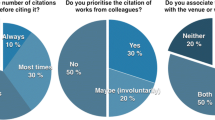Abstract
Optics is an important research domain both for its scientific interest and industrial applications. In this paper, we constructed a citation network of papers and performed topological clustering method to investigate the structure of research and to detect emerging research domains in optics. We found that optics consists of main five subclusters, optical communication, quantum optics, optical data processing, optical analysis and lasers. Then, we further investigated the detailed subcluster structures in it. By doing so, we detected some emerging research domains such as nonlinearity in photonic crystal fiber, broad band parametric amplifier, and in-vivo imaging techniques. We also discuss the distinction between research front and intellectual base in optics.
Similar content being viewed by others
References
D. J. D. Price, Little Science, Big Science, Columbia University Press, New York, 1963.
J. King, A Review of bibliometric and other science indicators and their role in research evaluation, Journal of Information Science, 13 (5) (1987) 261–276.
E. C. M. Noyons, H. F. Moed, M. Luwel, Combining mapping and citation analysis for evaluative bibliometric purposes: A bibliometric study, Journal of the American Society for Information Science and Technology, 50 (2) (1999) 115–131.
R. Rousseau, Journal evaluation: Technical and practical issues, Library Trends, 50 (3) (2002) 418–439.
K. Börner, C. Chen, K. W. Boyack, Visualizing knowledge domains, Annual Review of Information Science and Technology, 37 (2003) 179–255.
R. N. Kostoff, D. R. Toothman, H. J. Eberhart, J. A. Humenik, Text mining using database tomography and bibliometrics: a review, Technology Forecasting and Social Change, 68 (3) (2001) 223–253.
K. W. Boyack, B. N. Wylie, G. S. Davidson, Domain visualization using VxInsight for science and technology management, Journal of the American Society for Information Science and Technology, 53 (2002) 764–774.
C. Chen, T. Cribbin, R. Macredie, S. Morar, Visualizing and tracking the growth of competing paradigms: two case studies, Journal of the American Society for Information Science and Technology, 53 (2002) 678–689.
H. Small, Tracking and predicting growth areas in science, Scientometrics, 68 (3) (2006) 595–610.
A. Verbeek, K. Debackere, M. Luwel, E. Zimmermann, Measuring progress and evolution in science and technology. I: The multiple uses of bibliometric indicators, International Journal of Management Reviews, 4 (2002) 179–311.
A. Kameoka, Evaluating research projects at TOSHIBA. designing a conceptual framework of evaluating research and technology development (RTD) programs, Scientometrics, 34 (1995) 427–439.
M.-Y. Tsay, S.-J. Jou, S.-S. Ma, A bibliometric study of semiconductor literature, Scientometrics, 49 (2000) 491–509.
M.-Y. Tsay, H. Xu, C.-W. Wu, Journal co-citation analysis of semiconductor literature, Scientometrics, 57 (2007) 7–25.
M.-Y. Tsay, H. Xu, C.-W. Wu, Author co-citation analysis of semiconductor literature, Scientometrics, 58 (2003) 529–545.
R. Furukawa, A. Goto, Core scientists and innovation in Japanese electronics companies, Scientometrics, 68 (2006) 227–240.
M.-H. Huang, L.-Y. Chiang, D.-Z. Chen, Constructing a patent citation map using bibliographic coupling: A study of Taiwan’ high-tech companies, Scientometrics, 58 (2003) 489–506.
R. Rojo, I. Gómez, Analysis of the Spanish scientific and technological output in the ICT sector, Scientometrics, 66 (2006) 101–121.
J. Guan, N. Ma, A bibliometric study of China’s semiconductor literature compared with other major asian countries, Scientometrics, 70 (2007) 107–124.
J. Guan, Y. He, Comparison and evaluation of domestic and international outputs in Information Science & Technology research of China, Scientometrics, 65 (2006) 215–244.
V. Trimble, Productivity and impact of large optical telescopes, Scientometrics, 36 (2) (1996) 237–246.
M. E. J. Newman, Fast algorithm for detecting community structure in networks, Physical Review, E 69 (2004) 066133.
M. E. J. Newman, M. Girvan, Finding and evaluating community structure in networks, Physical Review, E 69 (2004) 026113.
R. Klavans, K. W. Boyack, Identifying a better measure of relatedness for mapping science, Journal of the American Society for Information Science and Technology, 57 (2006) 251–263.
Author information
Authors and Affiliations
Corresponding author
Rights and permissions
About this article
Cite this article
Takeda, Y., Kajikawa, Y. Optics: a bibliometric approach to detect emerging research domains and intellectual bases. Scientometrics 78, 543–558 (2009). https://doi.org/10.1007/s11192-007-2012-5
Received:
Published:
Issue Date:
DOI: https://doi.org/10.1007/s11192-007-2012-5




